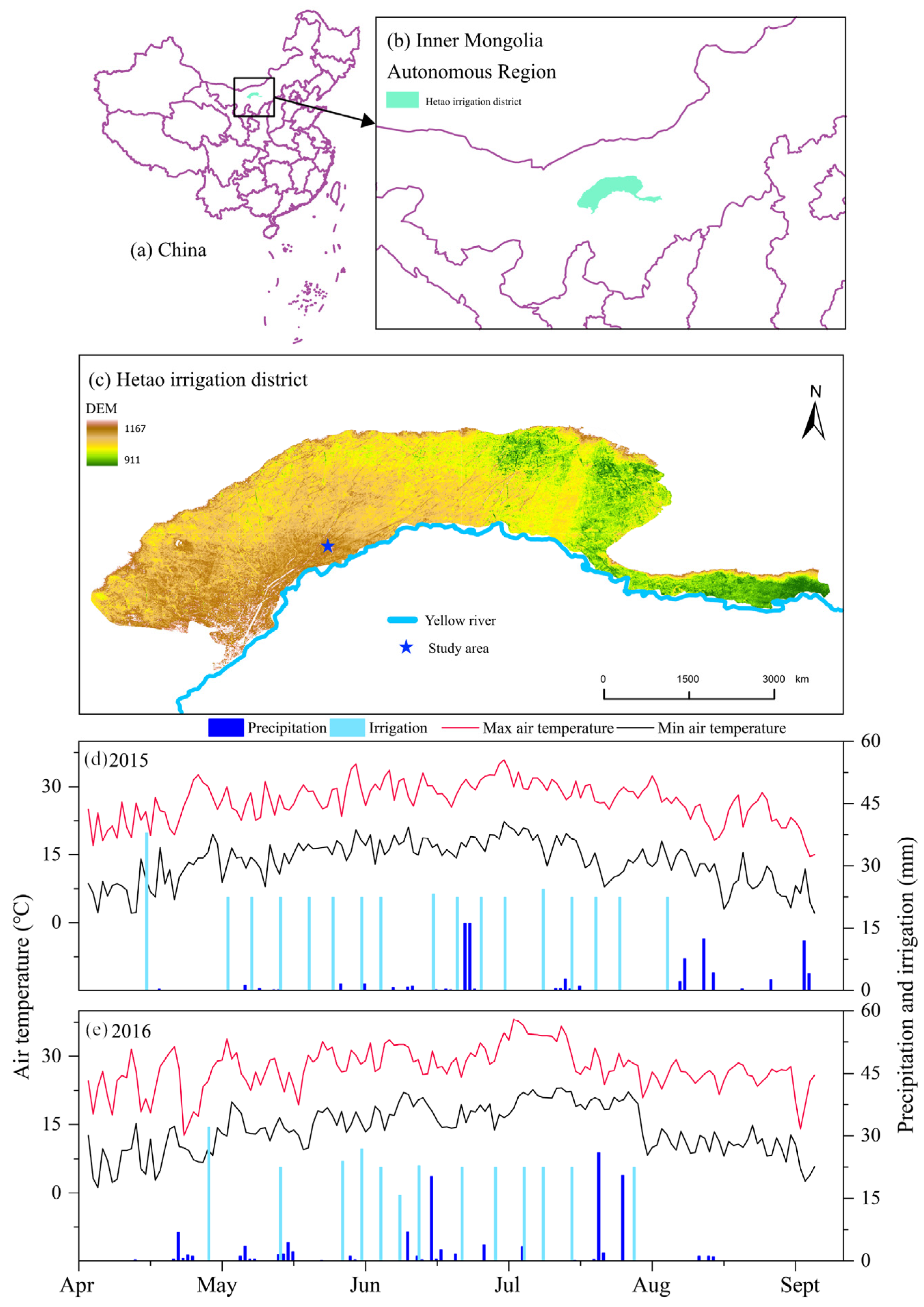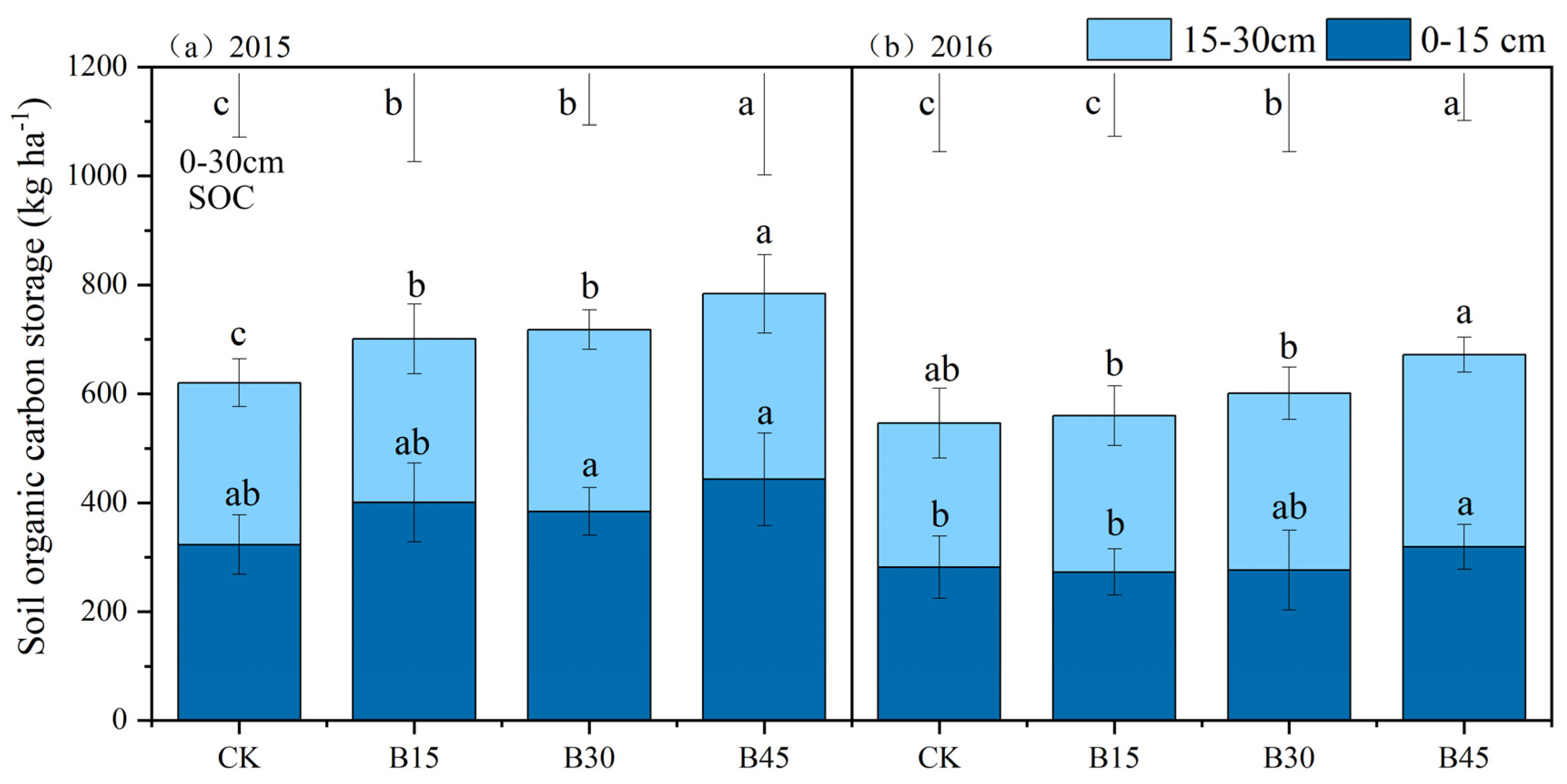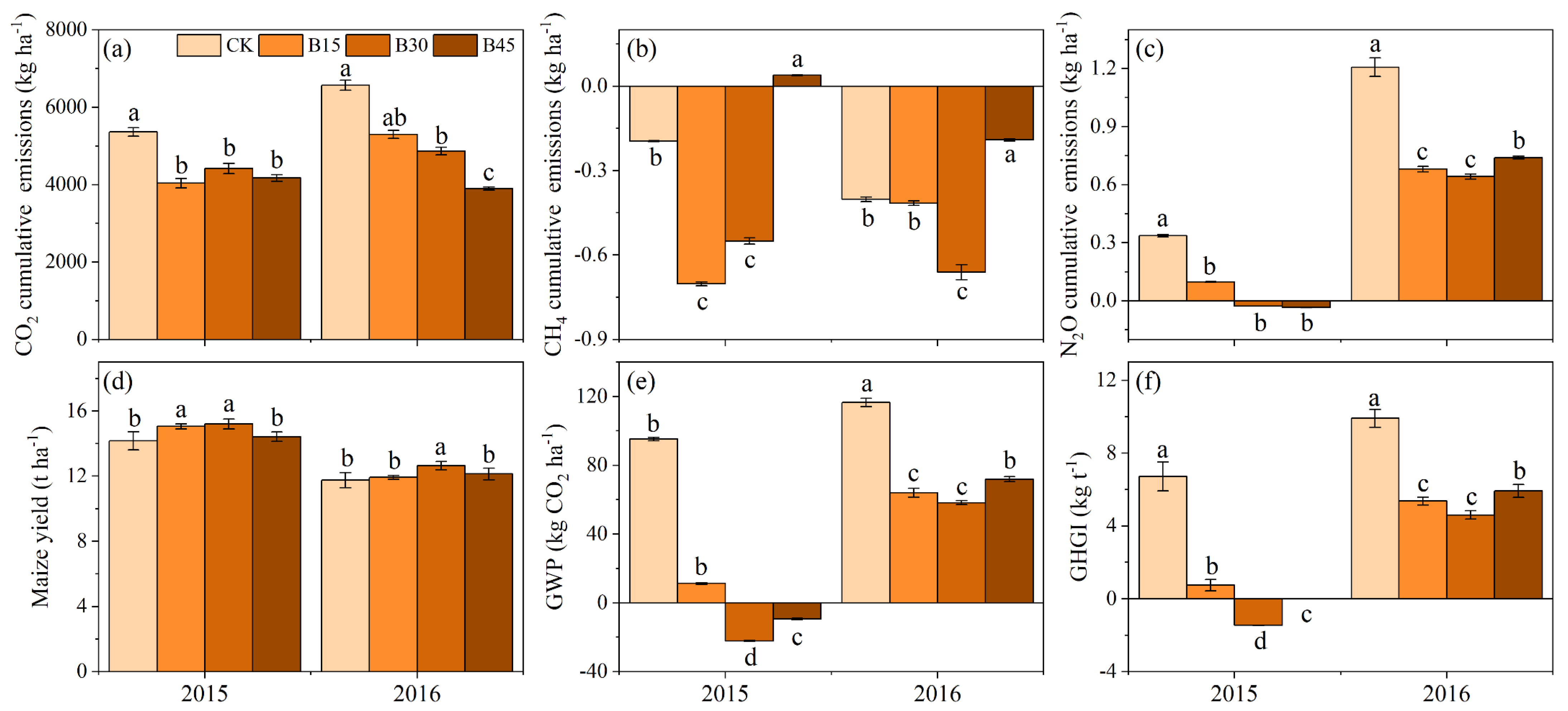Mitigation of Greenhouse Gas Emissions Using Straw Biochar in Arid Regions of Northwest China: Evidence from Field Experiments
Abstract
:1. Introduction
2. Materials and Methods
2.1. Field Experiment
2.1.1. Experimental Location
2.1.2. Characteristics of Biochar and Field Application Scheme
2.2. Sampling and Measurements
2.2.1. Measurements of Soil GHG Fluxes
2.2.2. Test Treated Samples
2.3. Calculations
2.4. Data Analysis
3. Results
3.1. Topsoil Organic Carbon Storage (SCS) and the Sub-Fertility Index
3.2. Soil Greenhouse Gas Emissions and Impacts
3.3. Carbon Footprint and Net Ecosystem Carbon Budget
3.4. Comprehensive Evaluation of Effect of Adding Biochar to Farmland
4. Discussion
4.1. Adding Biochar Increased NECB and Improved Soil Environment by Increasing NPP and Reducing GHG Emissions
4.2. Biochar Could Decrease CF by Enhancing Soil Carbon Sequestration and Reducing GHG Emissions from Soil
5. Conclusions
Supplementary Materials
Author Contributions
Funding
Data Availability Statement
Acknowledgments
Conflicts of Interest
References
- Xu, F.; Qu, Y.; Bento, V.A.; Song, H.; Qiu, J.; Qi, J.; Wan, L.; Zhang, R.; Miao, L.; Zhang, X.; et al. Understanding Climate Change Impacts on Drought in China over the 21st Century: A Multi-Model Assessment from CMIP6. NPJ Clim. Atmos. Sci. 2024, 7, 32. [Google Scholar] [CrossRef]
- Zheng, X.; Streimikiene, D.; Balezentis, T.; Mardani, A.; Cavallaro, F.; Liao, H. A Review of Greenhouse Gas Emission Profiles, Dynamics, and Climate Change Mitigation Efforts across the Key Climate Change Players. J. Clean. Prod. 2019, 234, 1113–1133. [Google Scholar] [CrossRef]
- Shi, Y.; Huang, G.; An, C.; Zhou, Y.; Yin, J. Assessment of Regional Greenhouse Gas Emissions from Spring Wheat Cropping System: A Case Study of Saskatchewan in Canada. J. Clean. Prod. 2021, 301, 126917. [Google Scholar] [CrossRef]
- Clark, M.A.; Domingo, N.G.G.; Colgan, K.; Thakrar, S.K.; Tilman, D.; Lynch, J.; Azevedo, I.L.; Hill, J.D. Global Food System Emissions Could Preclude Achieving the 1.5° and 2 °C Climate Change Targets. Science 2020, 370, 705–708. [Google Scholar] [CrossRef] [PubMed]
- Wang, L.; Li, L.; Cheng, K.; Pan, G. Comprehensive Evaluation of Environmental Footprints of Regional Crop Production: A Case Study of Chizhou City, China. Ecol. Econ. 2019, 164, 106360. [Google Scholar] [CrossRef]
- Bai, S.H.; Reverchon, F.; Xu, C.-Y.; Xu, Z.; Blumfield, T.J.; Zhao, H.; Van Zwieten, L.; Wallace, H.M. Wood Biochar Increases Nitrogen Retention in Field Settings Mainly through Abiotic Processes. Soil Biol. Biochem. 2015, 90, 232–240. [Google Scholar] [CrossRef]
- Hu, N.; Wang, B.; Gu, Z.; Tao, B.; Zhang, Z.; Hu, S.; Zhu, L.; Meng, Y. Effects of Different Straw Returning Modes on Greenhouse Gas Emissions and Crop Yields in a Rice–Wheat Rotation System. Agric. Ecosyst. Environ. 2016, 223, 115–122. [Google Scholar] [CrossRef]
- Chen, L.; Jiang, Y.; Liang, C.; Luo, Y.; Xu, Q.; Han, C.; Zhao, Q.; Sun, B. Competitive Interaction with Keystone Taxa Induced Negative Priming under Biochar Amendments. Microbiome 2019, 7, 77. [Google Scholar] [CrossRef]
- Zhao, J.; Qiu, Y.; Yi, F.; Li, J.; Wang, X.; Fu, Q.; Fu, X.; Yao, Z.; Dai, Z.; Qiu, Y.; et al. Biochar Dose-Dependent Impacts on Soil Bacterial and Fungal Diversity across the Globe. Sci. Total Environ. 2024, 930, 172509. [Google Scholar] [CrossRef]
- Xia, F.; Zhang, Z.; Zhang, Q.; Huang, H.; Zhao, X. Life Cycle Assessment of Greenhouse Gas Emissions for Various Feedstocks-Based Biochars as Soil Amendment. Sci. Total Environ. 2024, 911, 168734. [Google Scholar] [CrossRef]
- Adewale, C.; Reganold, J.P.; Higgins, S.; Evans, R.D.; Carpenter-Boggs, L. Agricultural Carbon Footprint Is Farm Specific: Case Study of Two Organic Farms. J. Clean. Prod. 2019, 229, 795–805. [Google Scholar] [CrossRef]
- Xiao, C.; Zhang, F.; Li, Y.; Fan, J.; Ji, Q.; Jiang, F.; He, Z. Optimizing Drip Irrigation and Nitrogen Fertilization Regimes to Reduce Greenhouse Gas Emissions, Increase Net Ecosystem Carbon Budget and Reduce Carbon Footprint in Saline Cotton Fields. Agric. Ecosyst. Environ. 2024, 366, 108912. [Google Scholar] [CrossRef]
- Zhang, S.; Xue, L.; Liu, J.; Xia, L.; Jia, P.; Feng, Y.; Hao, X.; Zhao, X. Biochar Application Reduced Carbon Footprint of Maize Production in the Saline−alkali Soils. Agric. Ecosyst. Environ. 2024, 368, 109001. [Google Scholar] [CrossRef]
- Gerakis, A.; Baer, B. A Computer Program for Soil Textural Classification. Soil Sci. Soc. Am. J. 1999, 63, 807–808. [Google Scholar] [CrossRef]
- Li, S.; Hu, M.; Shi, J.; Tian, X.; Wu, J. Integrated Wheat-Maize Straw and Tillage Management Strategies Influence Economic Profit and Carbon Footprint in the Guanzhong Plain of China. Sci. Total Environ. 2021, 767, 145347. [Google Scholar] [CrossRef] [PubMed]
- Wang, X.; Li, Y.; Feng, H.; Yu, Q.; Fan, X.; Liu, C.; Chen, J.; Yang, Z.; Biswas, A. Combining Biochar with Cotton-Sugarbeet Intercropping Increased Water-Fertilizer Productivity and Economic Benefits under Plastic Mulched Drip Irrigation in Xinjiang, China. Ind. Crops Prod. 2023, 192, 116060. [Google Scholar] [CrossRef]
- Hu, M.; Qu, Z.; Li, Y.; Xiong, Y.; Huang, G. Contrasting Effects of Different Straw Return Modes on Net Ecosystem Carbon Budget and Carbon Footprint in Saline-Alkali Arid Farmland. Soil Tillage Res. 2024, 239, 106031. [Google Scholar] [CrossRef]
- Bao, Y.X.; Xu, M.G.; Lv, F.T.; Huang, Q.H.; Nie, J.; Zhang, H.M.; Yu, H.Q. Evaluation Method on Soil Fertility under Long-Term Fertilization. Sci. Agric. Sin. 2012, 45, 4197–4204. [Google Scholar]
- Yang, W.; Feng, G.; Miles, D.; Gao, L.; Jia, Y.; Li, C.; Qu, Z. Impact of Biochar on Greenhouse Gas Emissions and Soil Carbon Sequestration in Corn Grown under Drip Irrigation with Mulching. Sci. Total Environ. 2020, 729, 138752. [Google Scholar] [CrossRef]
- Zhang, A.; Liu, Y.; Pan, G.; Hussain, Q.; Li, L.; Zheng, J.; Zhang, X. Effect of Biochar Amendment on Maize Yield and Greenhouse Gas Emissions from a Soil Organic Carbon Poor Calcareous Loamy Soil from Central China Plain. Plant Soil 2012, 351, 263–275. [Google Scholar] [CrossRef]
- Chai, Q.; Nemecek, T.; Liang, C.; Zhao, C.; Yu, A.; Coulter, J.A.; Wang, Y.; Hu, F.; Wang, L.; Siddique, K.H.M.; et al. Integrated Farming with Intercropping Increases Food Production While Reducing Environmental Footprint. Proc. Natl. Acad. Sci. USA 2021, 118, e2106382118. [Google Scholar] [CrossRef]
- Stocker, T. Climate Change 2013: The Physical Science Basis: Working Group I Contribution to the Fifth Assessment Report of the Intergovernmental Panel on Climate Change; Cambridge University Press: Cambridge, UK, 2014; ISBN 978-1-107-05799-9. [Google Scholar]
- Zhang, Y.; Xu, M.; Chen, H.; Adams, J. Global Pattern of NPP to GPP Ratio Derived from MODIS Data: Effects of Ecosystem Type, Geographical Location and Climate. Glob. Ecol. Biogeogr. 2009, 18, 280–290. [Google Scholar] [CrossRef]
- Buyanovsky, G.A.; Wagner, G.H. Crop Residue Input to Soil Organic Matter on Sanborn Field. In Soil Organic Matter in Temperate AgroecosystemsLong Term Experiments in North America; CRC Press: Boca Raton, FL, USA, 1996; ISBN 978-0-367-81169-3. [Google Scholar]
- Yang, X.; Xiong, J.; Du, T.; Ju, X.; Gan, Y.; Li, S.; Xia, L.; Shen, Y.; Pacenka, S.; Steenhuis, T.S.; et al. Diversifying Crop Rotation Increases Food Production, Reduces Net Greenhouse Gas Emissions and Improves Soil Health. Nat. Commun. 2024, 15, 198. [Google Scholar] [CrossRef] [PubMed]
- Grace, J.B. Structural Equation Modeling and Natural Systems; Cambridge University Press: Cambridge, UK, 2006; ISBN 978-1-139-45784-2. [Google Scholar]
- Yang, X.; Li, Z.; Ma, C.; Yang, Z.; Wei, J.; Wang, T.; Wen, X.; Chen, W.; Shi, X.; Zhang, Y.; et al. Microplastics Influence on Hg Methylation in Diverse Paddy Soils. J. Hazard. Mater. 2022, 423, 126895. [Google Scholar] [CrossRef]
- Xu, C.; Han, X.; Bol, R.; Smith, P.; Wu, W.; Meng, F. Impacts of Natural Factors and Farming Practices on Greenhouse Gas Emissions in the North China Plain: A Meta-Analysis. Ecol. Evol. 2017, 7, 6702–6715. [Google Scholar] [CrossRef]
- Keller, T.; Hüppi, R.; Leifeld, J. Relationship between Greenhouse Gas Emissions and Changes in Soil Gas Diffusivity in a Field Experiment with Biochar and Lime. J. Plant Nutr. Soil Sci. 2019, 182, 667–675. [Google Scholar] [CrossRef]
- Islam, M.U.; Jiang, F.; Guo, Z.; Peng, X. Does Biochar Application Improve Soil Aggregation? A Meta-Analysis. Soil Tillage Res. 2021, 209, 104926. [Google Scholar] [CrossRef]
- Yang, C.D.; Lu, S.G. Effects of Five Different Biochars on Aggregation, Water Retention and Mechanical Properties of Paddy Soil: A Field Experiment of Three-Season Crops. Soil Tillage Res. 2021, 205, 104798. [Google Scholar] [CrossRef]
- Case, S.D.C.; McNamara, N.P.; Reay, D.S.; Whitaker, J. The Effect of Biochar Addition on N2O and CO2 Emissions from a Sandy Loam Soil—The Role of Soil Aeration. Soil Biol. Biochem. 2012, 51, 125–134. [Google Scholar] [CrossRef]
- Wiedemeier, D.B.; Abiven, S.; Hockaday, W.C.; Keiluweit, M.; Kleber, M.; Masiello, C.A.; McBeath, A.V.; Nico, P.S.; Pyle, L.A.; Schneider, M.P.W.; et al. Aromaticity and Degree of Aromatic Condensation of Char. Org. Geochem. 2015, 78, 135–143. [Google Scholar] [CrossRef]
- Cao, Y.; Shan, Y.; Wu, P.; Zhang, P.; Zhang, Z.; Zhao, F.; Zhu, T. Mitigating the Global Warming Potential of Rice Paddy Fields by Straw and Straw-Derived Biochar Amendments. Geoderma 2021, 396, 115081. [Google Scholar] [CrossRef]
- Qian, R.; Guo, R.; Liu, Y.; Naseer, M.A.; Hussain, S.; Liu, D.; Zhang, P.; Chen, X.; Ren, X. Biodegradable Film Mulching Combined with Straw Incorporation Can Significantly Reduce Global Warming Potential with Higher Spring Maize Yield. Agric. Ecosyst. Environ. 2022, 340, 108181. [Google Scholar] [CrossRef]
- Lloret, F.; Casanovas, C.; Peñuelas, J. Seedling Survival of Mediterranean Shrubland Species in Relation to Root:Shoot Ratio, Seed Size and Water and Nitrogen Use. Funct. Ecol. 1999, 13, 210–216. [Google Scholar] [CrossRef]
- Lu, W.; Ding, W.; Zhang, J.; Li, Y.; Luo, J.; Bolan, N.; Xie, Z. Biochar Suppressed the Decomposition of Organic Carbon in a Cultivated Sandy Loam Soil: A Negative Priming Effect. Soil Biol. Biochem. 2014, 76, 12–21. [Google Scholar] [CrossRef]
- Sun, Z.; Zhang, Z.; Zhu, K.; Wang, Z.; Zhao, X.; Lin, Q.; Li, G. Biochar Altered Native Soil Organic Carbon by Changing Soil Aggregate Size Distribution and Native SOC in Aggregates Based on an 8-Year Field Experiment. Sci. Total Environ. 2020, 708, 134829. [Google Scholar] [CrossRef] [PubMed]
- Mohan, D.; Abhishek, K.; Sarswat, A.; Patel, M.; Singh, P.; Pittman, C.U. Biochar Production and Applications in Soil Fertility and Carbon Sequestration-a Sustainable Solution to Crop-Residue Burning in India. RSC Adv. 2018, 8, 508–520. [Google Scholar] [CrossRef]
- Rogovska, N.; Laird, D.A.; Rathke, S.J.; Karlen, D.L. Biochar Impact on Midwestern Mollisols and Maize Nutrient Availability. Geoderma 2014, 230, 340–347. [Google Scholar] [CrossRef]
- Wang, L.; Xue, C.; Nie, X.; Liu, Y.; Chen, F. Effects of Biochar Application on Soil Potassium Dynamics and Crop Uptake. J. Plant Nutr. Soil Sci. 2018, 181, 635–643. [Google Scholar] [CrossRef]
- Meena, V.S.; Maurya, B.R.; Verma, J.P. Does a Rhizospheric Microorganism Enhance K+ Availability in Agricultural Soils? Microbiol. Res. 2014, 169, 337–347. [Google Scholar] [CrossRef]
- Bai, J.; Song, J.; Chen, D.; Zhang, Z.; Yu, Q.; Ren, G.; Han, X.; Wang, X.; Ren, C.; Yang, G.; et al. Biochar Combined with N Fertilization and Straw Return in Wheat-Maize Agroecosystem: Key Practices to Enhance Crop Yields and Minimize Carbon and Nitrogen Footprints. Agric. Ecosyst. Environ. 2023, 347, 108366. [Google Scholar] [CrossRef]
- Zhang, S.; Liu, J.; Feng, Y.; Hao, X.; Liang, Y.; Xue, L.; Zhao, X. Optimized Fertilization Mitigated Carbon and Nitrogen Losses in a Solonchak. Eur. J. Soil Sci. 2024, 75, e13474. [Google Scholar] [CrossRef]
- Nazir, M.J.; Li, G.; Nazir, M.M.; Zulfiqar, F.; Siddique, K.H.; Iqbal, B.; Du, D. Harnessing soil carbon sequestration to address climate change challenges in agriculture. Soil Tillage Res. 2024, 237, 105959. [Google Scholar] [CrossRef]
- Zhang, G.; Liu, S.; Wang, X.; Wang, X.; Zhang, Y.; Zhao, D.; Wen, X.; Han, J.; Liao, Y. Mixed Application of Controlled-Release Urea and Normal Urea Can Improve Crop Productivity and Reduce the Carbon Footprint under Straw Return in Winter Wheat-Summer Maize Cropping System. Eur. J. Agron. 2023, 151, 127002. [Google Scholar] [CrossRef]
- Chen, S.; Lu, F.; Wang, X.K. Estimation of greenhouse gases emission factors for China’s nitrogen, phosphate, and potash fertilizers. Shengtai Xuebao 2015, 35, 6371–6383. [Google Scholar] [CrossRef]








| Item | Unit | Sandy Loam | Biochar |
|---|---|---|---|
| Bulk density | (g cm−3) | 1.4 | 0.6 |
| pH | / | 8.5 | 9.1 |
| EC | (μS cm−1) | 318.5 | NA |
| Organic matter | (g kg−1) | 14.5 | 925.7 |
| Alkaline-N | (mg kg−1) | 14.5 | 159.2 |
| Olsen-P | (mg kg−1) | 5.3 | 394.2 |
| Olsen-K | (mg kg−1) | 184 | 784 |
| C mass fraction | (g kg−1) | NA | 47.2 |
| N mass fraction | (g kg−1) | NA | 0.7 |
| H mass fraction | (g kg−1) | NA | 3.8 |
| C/N | % | NA | 67 |
| Year | Treatment | pH | Nitrate Nitrogen (mg kg−1) | Available Phosphorus (mg kg−1) | Available Potassium (mg kg−1) | Organic Carbon (mg kg−1) | Sub-Fertility Index |
|---|---|---|---|---|---|---|---|
| 2015 | CK | 8.2 ab | 58.2 a | 2.7 c | 134.5 a | 17.5 a | 3.5 a |
| B15 | 8.2 ab | 62.1 a | 4.8 b | 152.0 a | 19.8 a | 3.9 a | |
| B30 | 8.1 b | 63.3 a | 5.1 b | 148.5 a | 20.3 a | 3.8 a | |
| B45 | 8.4 a | 59.7 a | 6.3 a | 124.5 a | 20.1 a | 4.0 a | |
| 2016 | CK | 8.4 b | 64.9 b | 19.8 c | 103.8 c | 15.4 b | 4.3 b |
| B15 | 8.5 b | 66.1 b | 20.5 c | 161.4 ab | 15.8 b | 4.8 ab | |
| B30 | 8.6 a | 75.5 a | 24.8 b | 146.0 b | 17.0 ab | 5.4 a | |
| B45 | 8.5 ab | 79.3 a | 29.7 a | 184.5 a | 19.0 a | 5.6 a |
Disclaimer/Publisher’s Note: The statements, opinions and data contained in all publications are solely those of the individual author(s) and contributor(s) and not of MDPI and/or the editor(s). MDPI and/or the editor(s) disclaim responsibility for any injury to people or property resulting from any ideas, methods, instructions or products referred to in the content. |
© 2025 by the authors. Licensee MDPI, Basel, Switzerland. This article is an open access article distributed under the terms and conditions of the Creative Commons Attribution (CC BY) license (https://creativecommons.org/licenses/by/4.0/).
Share and Cite
Jia, Y.; Sun, Y.; Zhang, D.; Yang, W.; Pang, J.; Siddique, K.H.M.; Qu, Z. Mitigation of Greenhouse Gas Emissions Using Straw Biochar in Arid Regions of Northwest China: Evidence from Field Experiments. Agronomy 2025, 15, 1007. https://doi.org/10.3390/agronomy15051007
Jia Y, Sun Y, Zhang D, Yang W, Pang J, Siddique KHM, Qu Z. Mitigation of Greenhouse Gas Emissions Using Straw Biochar in Arid Regions of Northwest China: Evidence from Field Experiments. Agronomy. 2025; 15(5):1007. https://doi.org/10.3390/agronomy15051007
Chicago/Turabian StyleJia, Yonglin, Yule Sun, Dongliang Zhang, Wei Yang, Jiayin Pang, Kadambot H. M. Siddique, and Zhongyi Qu. 2025. "Mitigation of Greenhouse Gas Emissions Using Straw Biochar in Arid Regions of Northwest China: Evidence from Field Experiments" Agronomy 15, no. 5: 1007. https://doi.org/10.3390/agronomy15051007
APA StyleJia, Y., Sun, Y., Zhang, D., Yang, W., Pang, J., Siddique, K. H. M., & Qu, Z. (2025). Mitigation of Greenhouse Gas Emissions Using Straw Biochar in Arid Regions of Northwest China: Evidence from Field Experiments. Agronomy, 15(5), 1007. https://doi.org/10.3390/agronomy15051007







